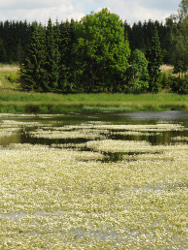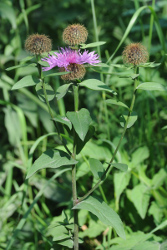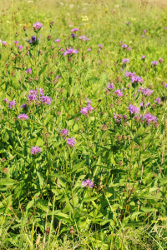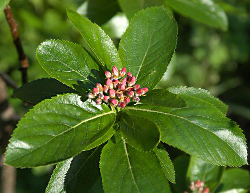I seek students of all degrees. The following theses topics are directly connected to my current research. In all cases the student will have an opportunity to learn and combine various methods, spanning from field work to a laboratory (depending on the type of study and student's individual interest).
Theses topics
Water-crowfoots: morphological, karyological and genetic variation and their evolution
Bc. & MSc. & Ph.D.: Water-crowfoots (Ranunculus sect. Batrachium) are beautiful but little known aquatic plants. Recently, in collaboration with colleagues at the Charles university (Prague) and Institute of Botany of the Czech Academy of Sciences (Průhonice), we carried out basic taxonomic revision in central Europe. Water-crowfoots are excellent model group to study many topics that are popular in current biology, such as polyploidy, hybridization, breeding systems (auto- vs. allogamy), phenotypic plasticity (aquatic vs. terrestrial plants, plants of one species from still vs. running waters) and conservation biology (as some species are rare and declining).
The particular thesis topics may include:- Variation (morphology, genome size) in a selected region
- Diversity in the Alps (unique types of alpine lakes and probably unique hybrids bound to stable alpine rivers)
- Hybridization: targeted search for and analysis of mixed populations; if able to cultivate the plants, we may test crossing experiments
- Terrestrial forms: what determination characters distinguish the species, what characters remain stable between aquatic and terrestrial plants, etc.
Advantages: interesting group, more people involved (= help with field collections), firm taxonomic basis, the methods are already successfully tested, bathing and canoeing as a part of scientific work.Biosystematics of Centaurea
Bc. & Mgr. & Ph.D.: The genus Centaurea - and especially its purple-flowering section Jacea - is considered a taxonomically very complex group. The main sources of problems include hybridization, polyploidy, overall similarity of the taxa (lack of determination characters). Distribution of some taxa is little known. Despite the intensive research during last ca 15 years, many questions remain opened:
The particular thesis topics may include:- Taxonomic revision of Centaurea stenolepis. This species occurs from the south-east of Czechia through the Carpathians and Pannonia to the Balkans (reaching Turkey). Subtle morphological differences are observed and different chromosome counts are reported from different parts of the species distribution. However, the variation must be studied based on representative sampling and confirmed also using molecular methods
- Taxonomic revision of poorly known putative endemic taxa (e.g. in the mountains of Romania and Bulgaria)
- Taxonomic revision of the C. scabiosa in Slovakia and Austria (possibly continuing to the Balkans). Several unclear putative endemic taxa are reported and information on chromosome counts, genome size, hybridization and morphology of many species is missing or only old literature records based on insufficient data are available.
- Other groups showing similar problems are for example C. jacea group over the whole Europe, C. nigrescens group in the Alps and southern Europe or C. nigra group in the western Europe…).
Advantages: interesting group, firm taxonomic basis, the methods are already successfully tested, travelling to beautiful and interesting countries.Hybridization of Centaurea at the landscape level
Bc. & Mgr.: The genus Centaurea is well-known for frequent hybridization and may thus serve as an excellent model group. In general, the species of the same ploidy level hybridizes freely while heteroploid hybrids seem to be very rare. However, the exact extent of hybridization in natural populations has never been properly analysed. The work will contribute also to the general question how to describe and quantify hybridization. The student may compare a pair of frequently crossing species (e.g. C. oxylepis and C. jacea in eastern Bohemia or central Moravia ) and a pair of rarely crossing species (e.g. C. pseudophrygia a C. jacea in southern Bohemia).
The work may be split between two separate theses (one species pair each).
Methods: Field survey of the selected region (tens of km2); census of individual populations (number of individuals, pure vs. mixed populations, frequency of hybrids). The hybrids can easily be determined based on morphology; determination may be confirmed using flow cytometry (genome sizes). The frequency of hybrids on various spatial scales and using various indices (percentage of hybrid individuas, percentage of population containg hybrids, etc.) will be compared with frequency of mixed populations, frequency of parental taxa within a population, etc.
Advantages: beautiful plants, simple methodology but valuable results, mostly a field work in one small region (no need for long travels).Reproduction biology of Sorbus chamaemespillus
Bc. & Mgr.: The genus Sorbus is taxonomically difficult. Due to frequent polyploidy, hybridization and apomixis (i.e. seeds are formed without fertilization and are genetic copy of the maternal individual) it comprises many genetic lineages that are often recognized as micro-species. However, they originate from hybridization from only a limited number of sexual diploid "basic" taxa. Among them, Sorbus chamaemespilus has an exceptional position as it is the only one growing in high mountains at or above the timberline and has both diploid and polyploid populations (the occurrence of polyploids may suggest that the species actually combines sexual and apomictic reproduction). However, the breeding system of this species is virtually unknown, as well as distribution of individual cytotypes and level of recent hybridization with other taxa. The aim of work will thus be understanding the reproduction biology of this species rather than taxonomical classification.
Methods: Field sampling in the Alps and Carpathians (the species does not occur in Czechia); flow cytometry (adult plants, seeds – the flow cytometric seed screen method, pollen), molecular analyses (microsatellites – to estimate genetic variation of populations and infer possible introgression from other species). The thesis will be co-supervised by M. Lepší (a specialist in Sorbus taxonomy and breeding systems).
Advantages: beautiful plants in beautiful environment of high mountains, topic popular among the contemporary biology, international collaboration, all methods tested and routinely used in our laboratory



